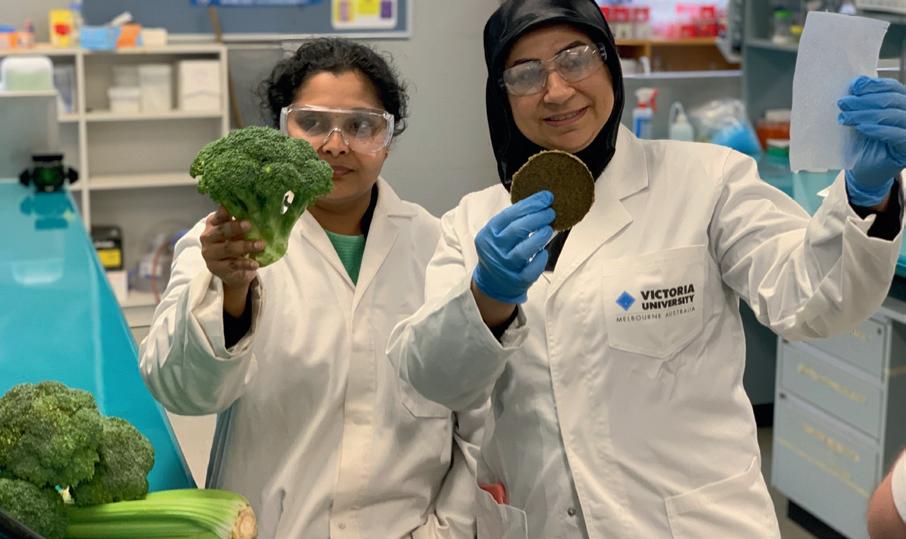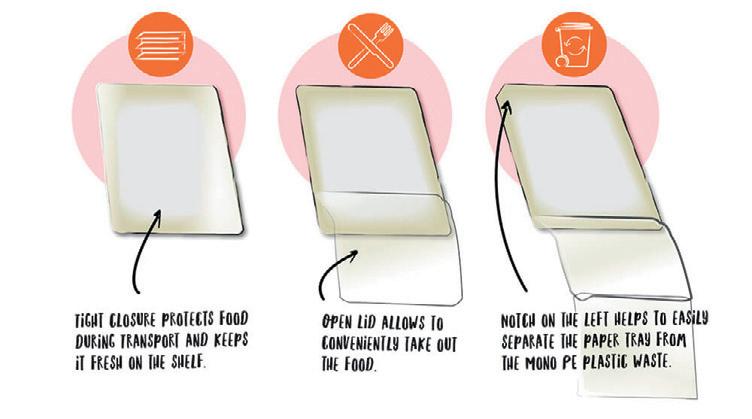
2 minute read
CASE STUDY Making packaging from vegetable waste
With an Australian Government target for all packaging to be reusable, recyclable or compostable by 2025, Victoria University researchers have been looking at how agricultural waste from vegetables such as zucchini, broccoli, celery and lettuce could be used to create affordable and easily compostable packaging.
Polymer expert Dr Marlene Cran and her team have been working in the research labs at VU’s Werribee Campus with the unusable produce provided by a nearby Werribee South market-farm. Leaves, stems and rejected produce is normally used as animal feed, composted or can be sent to landfill where it decomposes and produces methane gas. Instead, the team has created a range of food packaging products using the waste vegetables.
VU researchers found celery’s high cellulose content is good for making food trays, whereas zucchini, broccoli and lettuce can be processed into thick films that could be suitable as a tray insert or produce separator. Mycelium — the root structure of mushrooms — can be grown on the partially dried waste materials to make a replacement for Styrofoam boxes.
Recyclable packaging trays for fresh food
Mondi has launched two tray packaging products — PerFORMing Monoloop and Mono Formable PP — to provide recyclable options for fresh food manufacturers.

Both the recyclable packaging products come with high barrier food protection, one is a paper-based tray and the other is a semi-rigid plastic tray.

The trays are designed to protect fresh food contents at every stage of the manufacturing and logistics process, ensuring they last longer and the potential to apply MAP (modified atmosphere packaging) to extend the shelf life. The packaging inhibits exposure to elements such as moisture, gases and grease, and actively encourages correct consumer use, through resealable functions. This aids convenience and ease of portion control while also reducing food waste.
The team’s goal is to use minimal interventions such as intensive drying or the use of excessive additives so that the processes are as natural and inexpensive as possible, and easier to scale up in the future.
Away from the farm, the team is using starch waste material left over from the extraction of proteins from yellow peas to create a flexible film that could become the new plastic in a true circular economy.
“In future there could be protein powders or dried peas sold in a bag made from the leftover starch sourced from the vegetables… inside the bag,” Cran said. “That’s the dream.”
Despite the lack of industry-grade testing facilities and the expense to test alternative packaging — meaning a possible long road ahead — Cran said it just makes sense to replace throw-away packaging with sustainable natural products.
“Designing something that can compete on price and effectiveness with plastic and foam is the work of decades. But the investment needs to start now.”
Victoria University www.vu.edu.au
PerFORMing Monoloop is a formable and recyclable paper-based solution for sliced food such as cheese or meat. The paper tray with a barrier layer is combined with a plastic top web solution, allowing good product protection while reducing plastic use. The barrier layer can be easily separated from the paper tray so that all elements can be disposed of in the correct waste streams separately. It is certified recyclable by Institute cyclos-HTP and is suitable for a range of depths and forms on existing lines.
Mono Formable PP is a recyclable high barrier MAP solution, created from mono-material polypropylene (PP). Featuring a printed top web and a complementary thermoformable semi rigid bottom web, the fully recyclable packaging weighs around 30% less than a comparable polyester (PET) tray at the same thickness while offering the same high level of product protection. The solution can provide a substitute for the industry standard of multi-material non-recyclable PET trays and is available with a range of features like easy-peel for convenient opening and/or reclosure.
Mondi Group www.mondigroup.com/en/home









